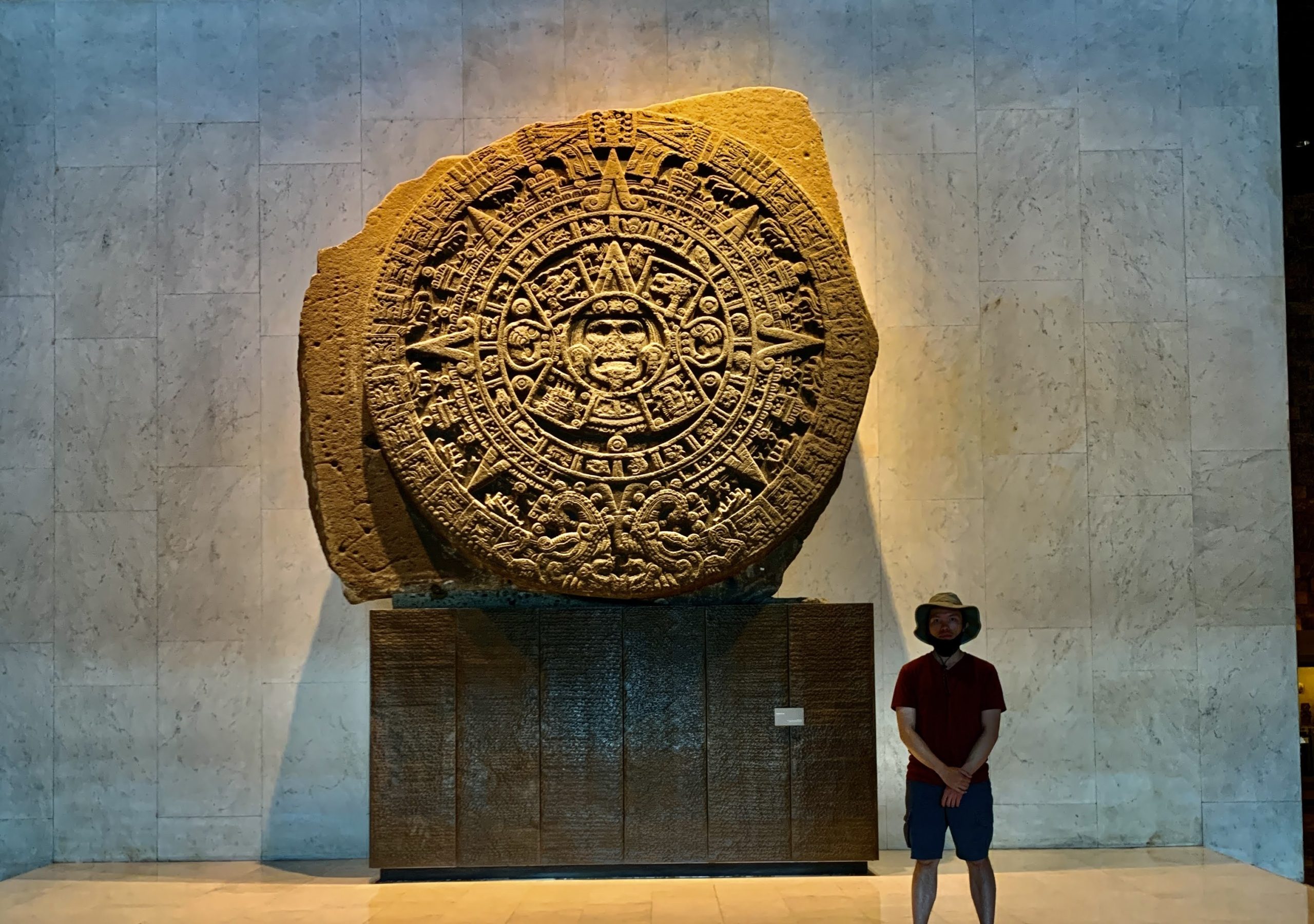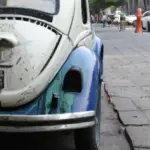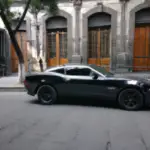Mexico City Art (Museums, Galleries, and Fantastic Alebrijes)
When I first arrived in Mexico City, I had no expectations except for what I might have seen in a movie or TV series. I know enough about traveling to know that the media never represents the full scope of what’s beneath a city. This contrast hit me the most when visiting Mexico City.
Mexico City is a cultural hub full of ancient and modern art that captures the essence of Mexico City’s past and future. From the magical world of Aztec Sun Stones, to the dreams of fantastical creatures made into alebrije sculptures – art in Mexico City is truly eclectic and ubiquitous.
It all started when I booked an art tour with a local guide. To my surprise he had an advanced degree in arts. I think it was a PhD in Mexican Literature. He even had self published books on Mexican folklore.
For 5 days we explored Mexico City. Each day my tour guide gave me a wealth of knowledge about every park, gallery, market and museum we explored.
After the tour, I could see the intertwinings of current culture and its relationship with the history in which the art was symbolic of. But not only its history, but also the future of Mexico’s culture.
This article is mostly a recollection of the tours we did.
National Art Museum (Museo Nacional de Arte MUNAL)
The best place to learn the most about recent Mexican culture would be in Mexico City’s National Art Museum. I say recent because this giant art gallery depicts primarily mid-sixteenth to 20th century art.
My tour guide and I explored every bit of this gallery. It had multiple levels and all of which were very large. If you have a tour guide, I would plan 3 to 4 hours to explore this museum. There is so much to see here.
The museum starts at the entrance with a Spanish Monarch sitting on top of a horse. It was a symbol of a time just before Mexican Independence.
When you enter the museum, you’ll have to go to the ticket booth and purchase admittance. Then after that you can start exploring.
On one of the floors we went to was a section dedicated to women artists. On this floor my tour guide started to mention how he preferred these paintings over the art made by Fridha Kahlo.
I thought of a couple things. First off, although I like some art over others, I don’t think I could make a distinction between the art made here. Props to my tour guide for knowing these things. The second was, there’s more depth to than what is mass marketed – it is a deep theme I’ve realized while living in Mexico.
I’ve digressed. If you don’t know who Fridha Kahlo is, she has a museum dedicated to her in Coyoacan, CDMX. She’s the woman with the unibrow you’ll see in a lot of Mexican art depictions. It was likely her husband was the one who painted her portrait. He goes by the name, Diego Rivera.
This portrait is called Retrato de Adolfo Best Maugard by Diego Rivera. Diego Rivera painted this while he was in France. The man in the portrait was also an artist but better known as a screenwriter.
Below is another example of art I found there. I like art because it’s a gateway to culture and history. But I also like art based on raw emotion. When I see below, I just think that’s freaking cool. The colors are alive and you can almost see the people moving with how excited everyone is celebrating.
(Above is called the Feria de San Juan.)
Religion, specifically Catholicism plays a huge role in a large part of Mexican art. It was a significant portion of the tour.
The painting below is an example. It’s called the Assumption of the Virgin by Titan.
Google Maps: https://g.page/munal-inba?share
Instagram: https://www.instagram.com/munalmx
Cost of Entry: $70 MXN Pesos and an additional $5 MXN Pesos for photography. (~$3.50 and $0.25 USD respectively)
Chapultepec Castle (Castillo de Chapultepec)
(Me in front of the Chapultepec Park aka Bosque de Chapultepec. The statue is called Los Niños Héroes. Or the Children Heroes.)
Chapultepec Castle was closed (pandemic reasons) when my tour guide and I went. It was located in Chapultepec Forest. It is a park which is equivalent to New York City’s Central Park. We did get to walk around the park while explaining the history of Mexico City and the significance Chapultepec Castle was during the Mexican-American war.
When Mexico City started opening up post-pandemic, I decided to visit Chapultepec Castle again. This time with a friend. Below are the photos.
Above picture depicts Bernardo de Galvez, a Spanish military leader who aided the USA in war time. The portrait is called El Ecsmo Señor Conde de Galvez.
Above photo is called El Abrazo (The Embrace in English) by Mexican painter Jorge González Camarena. It represents the merging of two different cultures – Mexican Eagle Warrior and the Spanish Conquistador.
Above the photo was taken on top of the Chapultepec Castle which hosts the National History Museum. It’s surrounded by a well kept garden and has views which overlook the city.
Cost: $70 MXN Pesos or ~$3.50 USD. It’s free for children under 13.
Google Maps: https://goo.gl/maps/xm24EKKb1qmz7vki8
Instagram: https://www.instagram.com/museodehistoria/?hl=en
National Anthropology Museum
I had the most fun visiting this museum. I’m highly curious about ancient civilizations and their technologies. For instance how did ancient people create giant structures, or figure out a calendar based on the Earth’s relationship with the sun.
Atlantean Warrior
The National Anthropology Museum was filled with artifacts and statues related to mostly the Mayan and Aztec civilizations. As per above example, was a photo I took of a structure named the Aztec Atlantean Warrior.
Aztec Sun Stone
Above is the Aztec Sun Stone. This post-Classic Mexica sculpture represents the cyclical aspects of time and is based on the Aztec solar calendar.
This was also used as an altar for gladiator style events. The idea was that sacrifice would bring abundance from the Aztec gods.
Cost: $75 MXN Pesos or ~$3.25 USD
Instagram: https://www.instagram.com/mnantropologia/?hl=en
Google Maps: https://goo.gl/maps/oSJ7Rhzutcau2tPeA
Alebrijes
This form of art has recently gained attention.
In 1936, Pedro Linares López had a dream in which he saw beasts and creatures he thought were fantastic. Each creature was different from the last. Some symbolic of more than two creatures. All were made of magnificent colors.
And before he would wake up from his dream, he heard the word Alebrijes. When he woke he began to sculpt the creatures he would see in his dream and aptly named them Alebrijes.
Originally these beasts were made of paper maché. Now they are commonly made from Copal wood and painted over with acrylic to make them last longer.
Where to find: Coyoacan Market or Pop Up Art Stores
Cost: Varies. In the above photo, I paid around $100 USD.
Get a Local Tour Guide to Understand Mexico City’s Art
If you’ve never had a tour guide who is well versed in the arts, going on an experience like this will fill you with insight.
I wish I had my tour guide on call sometimes just so he could explain the history and the symbolism of different types of artistic works I find throughout the city. I certainly need it. It seems like there is a corner in every neighborhood that has a art representative to the particular area.




